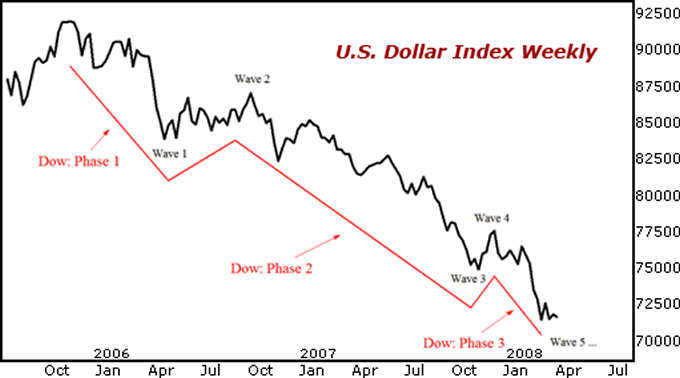Chart Pattern
Chart pattern analysis can be used to make short-term or long-term forecasts. The data can be intraday, daily, weekly or monthly and the patterns can be as short as one day or as long as many years. Gaps and outside reversals may form in one trading session, while broadening tops and dormant bottoms may require many months to form.

Market Analysis
Elliott Wave
Elliott Wave theory states that prices move in waves. These waves occur in a repeating pattern of a (1) move up, (2) then a partial retracement down, (3) another move up, (4) a retracement, (5) then finally a last move up. Then, there is a (A) full retracement, followed by a (B) partial retracement upward, then (C) a full move downward. This repeats on a macro and micro time frame. A visual illustration of the basic pattern of the Elliott Wave is given below. A real life example of Elliott Wave in action is given further down:

Three Rules
Believe it or not, there are only three rules when it comes to interpreting Elliott Wave. There are many guidelines, but only three HARD rules. These are unbreakable. Guidelines, on the other hand, are bendable and subject to interpretation. Furthermore, these rules only apply to a 5-wave impulse sequence. Correction, which are much more complicated, are given more leeway when it comes to interpretation.
Rule 1: Wave 2 cannot retrace more than 100% of Wave 1.
Rule 2: Wave 3 can never be the shortest of the three impulse waves.
Rule 3: Wave 4 can never overlap Wave 1.
Rule 1: Wave 2 cannot retrace more than 100% of Wave 1.
Rule 2: Wave 3 can never be the shortest of the three impulse waves.
Rule 3: Wave 4 can never overlap Wave 1.
Wyckoff Market Analysis

Two Rules
Wyckoff focused exclusively on price action. Earnings and other fundamental information were simply too esoteric and imprecise to be used effectively. Moreover, this information was usually already factored into the price by the time it became available to the average speculator.
Rule One: Don't expect the market to behave exactly the same way twice. The market is an artist, not a computer. It has a repertoire of basic behavior patterns that it subtly modifies, combines and springs unexpectedly on its audience. A trading market is an entity with a mind of its own.
Rule Two: Today's market behavior is significant only when it's compared to what the market did yesterday, last week, last month, even last year. There are no predetermined, never-fail levels where the market always changes. Everything the market does today must be compared to what it did before.
Rule One: Don't expect the market to behave exactly the same way twice. The market is an artist, not a computer. It has a repertoire of basic behavior patterns that it subtly modifies, combines and springs unexpectedly on its audience. A trading market is an entity with a mind of its own.
Rule Two: Today's market behavior is significant only when it's compared to what the market did yesterday, last week, last month, even last year. There are no predetermined, never-fail levels where the market always changes. Everything the market does today must be compared to what it did before.
Wyckoff Stock Analysis
Four Stages
Before looking at the stock selection process in detail, keep in mind the four phases of price movement: accumulation, markup, distribution and markdown. It is important to understand the price position for the broad market and the individual stock before initiating a trade. Long positions are preferred when the broad market is in a markup stage.

Outside of the markup stage, there are five other buy points that offer a good risk-reward ratio. Aggressive traders would attempt to pick a bottom by buying on the spring. Trend followers would buy on the breakout that signals the start of an uptrend. Once the breakout has taken place, chartists can also look to establish long positions during throwbacks, re-accumulation phases or corrections.

Short positions are preferred when the broader market is in a markdown stage. Aggressive traders would become active when a lower peak forms or thrust pattern forms, which is a failed resistance breakout. This is clearly a top picking exercise with above average risk of failure. Trend followers would be most apt to sell on a support break that signals a clear trend reversal. After the break down, chartists can look to establish short positions during throwbacks, re-distribution phases and corrections.
Dow Theory
“There are three movements of the averages, all of which may be in progress at one and the same time.
- The first, and most important, is the primary trend: the broad upward or downward movement known as bull or bear markets, which may be of several years duration.
- The second, and most deceptive movement, is the secondary reaction: an important decline in a primary bull market or a rally in a primary bear market. These reactions usually last from three weeks to as many months.
- The third, and usually unimportant, movement is the daily fluctuation”
Example

Credits
- www.stockcharts.com
- www.smallstocks.com.au
- www.marketoracle.co.uk

